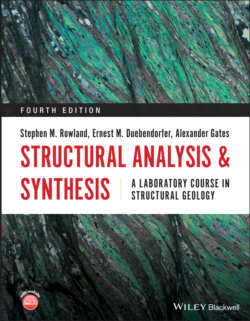Читать книгу Structural Analysis and Synthesis - Stephen M. Rowland - Страница 16
Structural Elements
ОглавлениеThe structural elements observed in an outcrop must be carefully discerned as actual components of the rock before they are measured. Many students attempt to take measurements from the surface of outcrops which generally are not suitable data. In most cases, it is better to extend the observed feature away from the outcrop surface with a book for planar features or a wooden pencil for linear features. This smooths uneven surfaces and eliminates the influence of magnetite or other magnetic minerals on the magnetic compass needle. Care must be taken that the tools used to extend the elements are not themselves magnetic.
Planar and linear elements have standard notations for use on geologic maps (Table 1.1). Planar elements include primary features such as bedding and dikes, as well as secondary features such as foliations including cleavages, faults, and joints. By convention, bedding is designated So as the most basic of surfaces. The foliations that overprint bedding are labeled S1–Sn, with S1 the earliest tectonic cleavage (typically slaty), followed by successive overprinting crenulation cleavages S2–Sn. In metamorphic rocks, foliations such as schistosity and gneissosity cannot be related to bedding so cannot follow the S1–Sn system. Instead, the oldest recognizable surface can be designated Sx and subsequent foliations designated Sx + 1 and so on.
There are primary planar features that can be used to reconstruct areas and document strain but don’t have S surface designations. For example, foresets in cross bedding can be used to determine flow directions and strain in some cases. They should be measured and documented.
Structural or secondary linear elements can be divided into two types, intersection lineations and stretching lineations. The intersection of any two planar surfaces produces a lineation. These can range from discrete features like pencil cleavages to more subtle features like wrinkles on foliation surfaces. It is best to measure the two planar features that create the lineation in most cases. These lineations can be designated by the two intersecting surfaces such as L1 × 2 (S2 crossing S1) for reference. Stretching lineations are of more common interest. They can be slickensides on faults or any linear fabric in an L or LS tectonite. In particular, lineations in shear zones are important because they can show movement sense, like slickensides. If needed, these can also be labeled by generation such as L1. Fold axes/hinge lines are measured as lineations (intersection).
There are also primary linear features that should be documented for reconstruction of a field area. In sedimentary rocks, parting lineations, flute casts, and groove casts among others can be documented and measured to help determine flow direction and strain in some cases. Plutonic and volcanic rocks can contain flow foliations that are also useful.
Table 1.1 Common symbols used on geologic maps.
